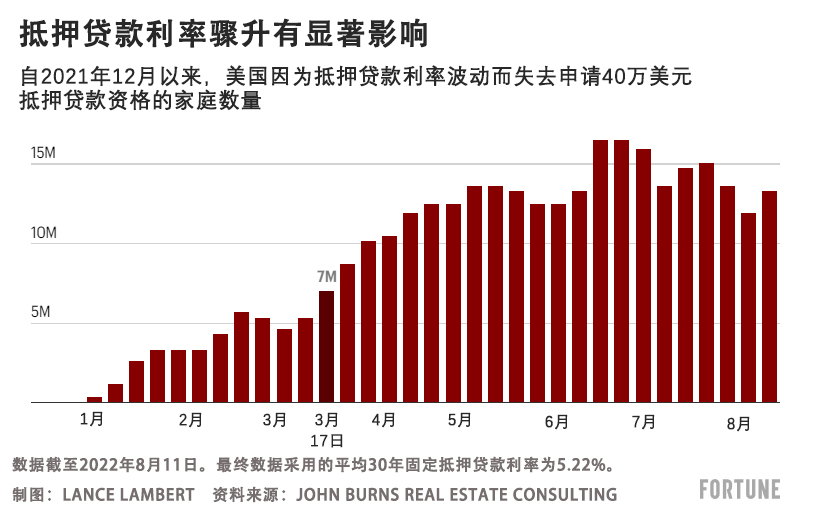今年春天,美联储(Federal Reserve)再次老生常谈,祭出了应对通货膨胀的法宝。事情是这样的:美联储发出短期利率将很快上浮的信号,给长期利率带来上行压力,包括抵押贷款利率。抵押贷款利率上浮降低了房屋销量和房屋建设量。这导致对大宗商品(例如木材和混凝土)和耐用品(比如厨房工作台和冰箱)的需求下降。这些方面的经济萎缩影响到整个经济,理论上有助于抑制通胀。
当然,房地产市场的回调阶段已经开始。
在美国,购房人开始暂停找房。新房销量和成品房销量同比分别下降了29.6%和20.2%。独栋住宅开工数量和抵押贷款购房申请数量分别减少了18.5%和23%。简而言之,房地产市场的活动正在快速萎缩。
无论你将这种情况称为房地产市场回调、房地产市场衰退还是房地产市场下滑,都远没有结束。以抵押贷款利率为例,今年年初,平均30年固定抵押贷款利率为3.1%。但这已经是很久以前的事情了。9月1日,该利率上涨到6.23%,为2022年第二高的水平。
如果以3.2%的利率抵押贷款500,000美元,月供就为2,162美元。如果利率为6.23%,同样一笔30年贷款的月供就为3,072美元。抵押贷款利率上涨以及新冠疫情期间房价的大幅上涨(43%),让许多潜在购房人无力支付现在的月供。还有家庭(见下图)彻底失去了抵押贷款资格。

行业内部人士表示,如果抵押贷款利率和房价始终居高不下,房地产市场就将持续下滑。
上周早些时候,高盛集团(Goldman Sachs)修改了对房地产市场的预测。该投资银行现在预测2022年房地产业GDP将下降8.9%,2023年再次下降9.2%。这将是后金融危机时代首次出现房地产市场下滑。罪魁祸首是什么?抵押贷款利率上升所导致的可负担性危机(见下图)。

对购房人而言坏消息是什么?抵押贷款利率可能要在一段时间之后才会有所下降。
穆迪分析(Moody’s Analytics)的首席经济学家马克·赞迪对《财富》杂志表示:“我依旧认为今年剩余时间平均固定利率将维持在5.5%。”
赞迪称,如果美国劳动力市场开始疲软,金融市场就会放宽抵押贷款利率;理论上,劳动力市场疲软和通胀下降,会促使美联储改变应对通胀的做法,下调利率。然而,劳动力市场持续过热,利率甚至会进一步上升。
赞迪说:“当然,如果劳动力市场依然有弹性,美联储就会以超出市场预期的力度,继续采取紧缩政策,而抵押贷款利率将变得更高,最终会对房地产市场造成更大的影响。”(财富中文网)
译者:刘进龙
审校:汪皓
今年春天,美联储(Federal Reserve)再次老生常谈,祭出了应对通货膨胀的法宝。事情是这样的:美联储发出短期利率将很快上浮的信号,给长期利率带来上行压力,包括抵押贷款利率。抵押贷款利率上浮降低了房屋销量和房屋建设量。这导致对大宗商品(例如木材和混凝土)和耐用品(比如厨房工作台和冰箱)的需求下降。这些方面的经济萎缩影响到整个经济,理论上有助于抑制通胀。
当然,房地产市场的回调阶段已经开始。
在美国,购房人开始暂停找房。新房销量和成品房销量同比分别下降了29.6%和20.2%。独栋住宅开工数量和抵押贷款购房申请数量分别减少了18.5%和23%。简而言之,房地产市场的活动正在快速萎缩。
无论你将这种情况称为房地产市场回调、房地产市场衰退还是房地产市场下滑,都远没有结束。以抵押贷款利率为例,今年年初,平均30年固定抵押贷款利率为3.1%。但这已经是很久以前的事情了。9月1日,该利率上涨到6.23%,为2022年第二高的水平。
如果以3.2%的利率抵押贷款500,000美元,月供就为2,162美元。如果利率为6.23%,同样一笔30年贷款的月供就为3,072美元。抵押贷款利率上涨以及新冠疫情期间房价的大幅上涨(43%),让许多潜在购房人无力支付现在的月供。还有家庭彻底失去了抵押贷款资格。
行业内部人士表示,如果抵押贷款利率和房价始终居高不下,房地产市场就将持续下滑。
上周早些时候,高盛集团(Goldman Sachs)修改了对房地产市场的预测。该投资银行现在预测2022年房地产业GDP将下降8.9%,2023年再次下降9.2%。这将是后金融危机时代首次出现房地产市场下滑。罪魁祸首是什么?抵押贷款利率上升所导致的可负担性危机。
对购房人而言坏消息是什么?抵押贷款利率可能要在一段时间之后才会有所下降。
穆迪分析(Moody’s Analytics)的首席经济学家马克·赞迪对《财富》杂志表示:“我依旧认为今年剩余时间平均固定利率将维持在5.5%。”
赞迪称,如果美国劳动力市场开始疲软,金融市场就会放宽抵押贷款利率;理论上,劳动力市场疲软和通胀下降,会促使美联储改变应对通胀的做法,下调利率。然而,劳动力市场持续过热,利率甚至会进一步上升。
赞迪说:“当然,如果劳动力市场依然有弹性,美联储就会以超出市场预期的力度,继续采取紧缩政策,而抵押贷款利率将变得更高,最终会对房地产市场造成更大的影响。”(财富中文网)
译者:刘进龙
审校:汪皓
This spring, the Federal Reserve dusted off the ole inflation-fighting playbook. It goes like this: The central bank applies upward pressure on long-term interest rates—including mortgage rates—through signaling that short-term rates will soon rise. Those spiking mortgage rates then push both home sales and homebuilding lower. That causes demand for commodities (like lumber and concrete) and durable goods (like countertops and refrigerators) to fall. Those economic contractions then spread throughout the rest of the economy and, in theory, help to curtail inflation.
The housing correction phase, of course, has already begun.
Across the country, home shoppers are putting their home search on pause. On a year-over-year basis, new home sales and existing home sales are now down 29.6% and 20.2%. And single-family housing starts and mortgage purchase applications are down 18.5% and 23%, respectively. Simply put: Housing activity is contracting—fast.
Regardless of what you call it—a housing correction, housing recession, or housing downturn—it is far from over. Just look at mortgage rates. Heading into the year, the average 30-year fixed mortgage rate sat at 3.1%. That’s long gone. On September 1, it climbed to 6.23%—the second highest mortgage rate reading of 2022.
If a borrower took out a $500,000 mortgage at a 3.2% rate, they’d see a $2,162 monthly payment. At a 6.23% rate, that monthly payment would be $3,072 over the 30-year loan. These elevated mortgage rates—coupled with frothy home prices that jumped 43% during the pandemic—simply make new monthly payments unaffordable for many would-be buyers. Other households (see chart below) have lost their mortgage eligibility altogether.
As long as mortgage rates and home prices both remain this high, industry insiders say the housing market will continue to slump.
Earlier last week, Goldman Sachs released a revised forecast. The investment bank now projects that housing GDP will fall 8.9% in 2022, and another 9.2% in 2023. That would mark the first housing downturn of the post–Great Financial Crisis era. The culprit? The affordability crunch (see chart below) caused by spiking mortgage rates.
The bad news for buyers? It could be a while before there’s much rate relief.
“I still expect fixed rates to average 5.5% through the remainder of the year,” Mark Zandi, chief economist at Moody’s Analytics, tells Fortune.
Once the U.S. labor market begins to weaken, Zandi says, financial markets should begin to ease up on mortgage rates; in theory, a weakened labor market, coupled with falling inflation, would lead the Fed to ease up on its inflation fight. However, if the overheated labor market persists, rates could go even higher.
“Of course, if the job market remains resilient, the Fed will need to tighten even more aggressively than markets are anticipating, and mortgage rates [would go] higher and the ultimate damage to the housing market [would be] greater,” notes Zandi.






